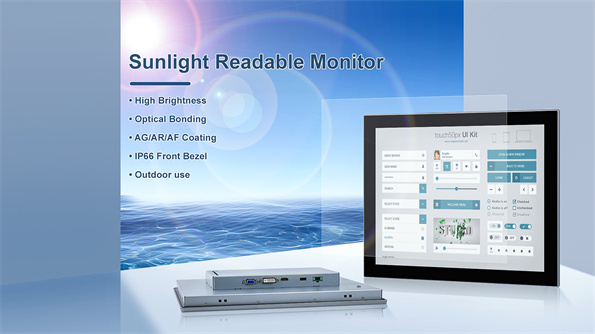Sunlight Readable Monitor
Time:2025-07-14 17:55:43
Visit:232

Working outdoors or in environments with direct sunlight—such as in maritime, oil, and gas industries—presents unique challenges. One of the most critical concerns is maintaining screen visibility under intense glare. This largely depends on the readability of the display. So, how can you ensure that a monitor remains clearly visible in various lighting conditions? Let’s explore the concept of sunlight readable monitors and understand how many nits are required to achieve true sunlight readability.
A sunlight readable monitor is engineered to provide optimal visibility in outdoor settings. These displays effectively address the challenge of intense ambient light by offering high brightness—many models deliver over 1000 nits—ensuring vivid and clear visuals even in direct sunlight.
Key features of sunlight readable monitors include:
These characteristics make sunlight readable touch screen monitors indispensable for outdoor environments. They significantly expand where and how displays can be used effectively.
Enhanced visibility translates directly into improved productivity. Field personnel can access critical data without misinterpretation, leading to more efficient and accurate task execution.
In addition, high-brightness screens are highly effective in digital signage applications. They attract attention effortlessly and deliver clear, vibrant images and text, improving user engagement and advertising impact.
Key benefits of using bright displays outdoors include:
Ultimately, bright monitors are essential tools across a wide range of outdoor scenarios—whether for work, advertising, or casual browsing—thanks to their reliable performance in bright environments.
Anti-glare and anti-reflective coatings reduce surface reflections, significantly improving screen legibility under sunlight. These technologies make it possible to maintain visibility even in the most demanding outdoor environments.
Sunlight readable technology is vital for industries that operate outdoors, including transportation, military, and outdoor advertising. Its ability to preserve screen clarity under various lighting conditions is transformative.
Core elements of sunlight readable displays include:
What Is a Sunlight Readable Monitor?
A sunlight readable monitor is engineered to provide optimal visibility in outdoor settings. These displays effectively address the challenge of intense ambient light by offering high brightness—many models deliver over 1000 nits—ensuring vivid and clear visuals even in direct sunlight.
Key features of sunlight readable monitors include:
- • High brightness levels, often exceeding 1000 nits
- • Anti-glare screens that minimize reflections
- • Rugged and weather-resistant construction
These characteristics make sunlight readable touch screen monitors indispensable for outdoor environments. They significantly expand where and how displays can be used effectively.
Advantages of Using a Bright Screen Outdoors
Enhanced visibility translates directly into improved productivity. Field personnel can access critical data without misinterpretation, leading to more efficient and accurate task execution.
In addition, high-brightness screens are highly effective in digital signage applications. They attract attention effortlessly and deliver clear, vibrant images and text, improving user engagement and advertising impact.
Key benefits of using bright displays outdoors include:
- • Clear visibility in direct sunlight
- • Enhanced effectiveness of outdoor advertising
- • Reduced eye strain in bright conditions
Ultimately, bright monitors are essential tools across a wide range of outdoor scenarios—whether for work, advertising, or casual browsing—thanks to their reliable performance in bright environments.
What Is Sunlight Readable Display Technology?
Anti-glare and anti-reflective coatings reduce surface reflections, significantly improving screen legibility under sunlight. These technologies make it possible to maintain visibility even in the most demanding outdoor environments.
Sunlight readable technology is vital for industries that operate outdoors, including transportation, military, and outdoor advertising. Its ability to preserve screen clarity under various lighting conditions is transformative.
Core elements of sunlight readable displays include:
- • High brightness output
- • Anti-glare surface coatings
- • Anti-reflective optical treatments
- • Rugged construction for outdoor use
What Makes a Display Readable in Sunlight?
1. Increasing backlight brightness:
2. Using transflective technology:
How Many Nits Is Considered Sunlight Readable?
Choosing the Right Sunlight Readable Monitor

